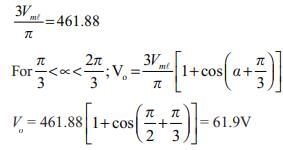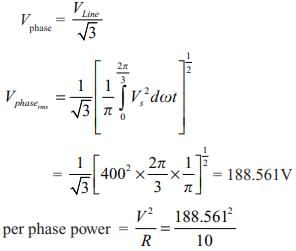Test: Three Phase Converters - 2 - Electrical Engineering (EE) MCQ
20 Questions MCQ Test - Test: Three Phase Converters - 2
A three-phase full converter supplied from a 230 V source is working as a line commutated inverter. The load consists of RLE type with R = 5 Ω, E = 200 V and L = 1 mH. A continues current of 10 A is flowing through the load, find the value of the firing angle delay.
A three-phase full converter is driving a DC motor. If a continues current of Im amperes is flowing through the motor load, then find the rms value of supply current drawn by the converter to drive the motor.
In the below given circuit, each SCR and diode conduct for
In the below given circuit, __ and __ conduct along with T2.
In a 3 – φ semi converter, for firing angle equal to 125° and extinction angle equal to 105°, each SCR and freewheeling diode conduct respectively for
A three phase Bridge rectifier as shown.

Which is more suitable sequence of operation for maximum out put
A 3-phase full converter feeds power to an R load of 10 Ω. For a firing angle delay of 30° the load takes 5 kW. An inductor of large value is also connected to the load to make the current ripple free. Find the value of per phase input voltage.
A three-phase semi-converter circuit is given a supply of 400 V. It produces at the output terminals an average voltage of 381 V. Find the rectification efficiency of the converter circuit.
In a 3-phase semi-converter, for firing angle less than 60° the freewheeling diode conducts for
In a 3-phase full wave converter, if V is the maximum value of line voltage at the input, then each SCR is subjected to a peak negative voltage of
A three phase full converter is supplying a purely resistive load at 400V d.c. for 30° firing angle. The output
voltage for 90° firing angle would be
The effect of source inductance on the performance of a 3-phase controlled converter is to
Which of the following converter circuits would require a neutral point?
A 12 pulse rectifier output generated with minimum and maximum value of _________
A 3-phase bridge converter is given a three-phase supply in the phase sequence R-Y-B. Let the neutral to R phase voltage be Vm sinωt. The first SCR (connected to R phase) is fired at an angle of 15°. What is the maximum value at the output terminals at this instant?
The PIV experienced by each SCRs in M-3 converter is __________ times that in a 3-phase full converter having the same output voltage.
In a 3φ converter and inverter circuit as shown in figure Vs = 400 V

A 3-phase full converter has an average output voltage of 365 V for zero degree firing and resistive load. For a firing angle of 90 degree, the output voltage would be




















